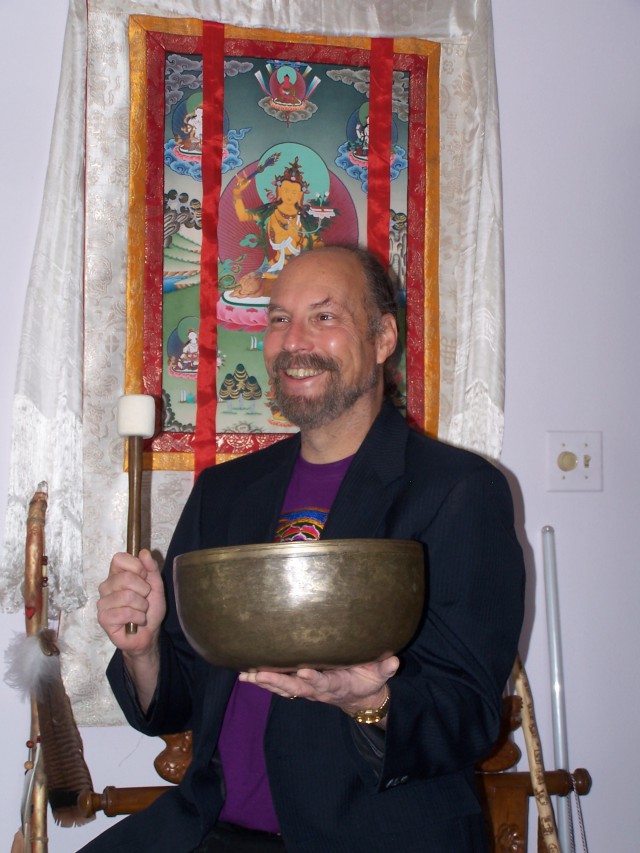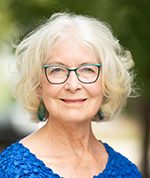
Past the meticulously manicured yard of Marybeth Keigher’s North Boulder house, surrounded by vibrant flowers and fountains, lies what appears to be a converted guesthouse that now serves as a studio for her acupuncture and sound healing practice.
Sun was streaming through a skylight in her studio as she greeted me warmly and welcomed me into her studio, a small rectangular room with a few chairs, a massage table, a gong, assorted golden bowls and other tools and decorations. Keigher, an acupuncturist since 1994 and a sound healer since 2000, explained some basics of sound healing to me — how her practice of “acutonics” is based on the acupuncture belief system of chakras and chi — and then it was time for a demonstration. I climbed on the table and she struck a pair of Tibetan hand cymbals called “tingshas” and waved them over my body.
“If we’re carrying around any heavy energy, it tends to just dissolve or move away from the body with this kind of tone,” she said, explaining the cymbals’ purpose in her sound healing. Despite my skepticism about the existence of any sort of energy not measurable in scientific units, I found the high, resonant ringing of the cymbals to be surprisingly relaxing.
Keigher encouraged me to disengage my “intellectual mind” as she struck a gong, supposedly tuned to 194.18 Hz, some numerology derived from the Earth’s rotation on its axis, behind my head. She took my pulse from my wrist and brought out special tuning forks with rubber balls on the end of them and struck them, sticking the vibrating ball on various acupuncture points on my back, legs and feet. After that she placed a few Tibetan singing bowls on my chest and struck them, sending the vibrations from the bowls into my body.
As skeptical as I was, I emerged from the session deeply relaxed. Though I can’t attest whether the experience truly cleared my chakras for better chi movement, I can’t deny that after the session I felt less stressed and slightly more alert, as if I had just gotten a light massage.
While
Western science has yet to find any sort of physical basis for the
system of meridians, chakras and chi that form the basis of sound
healing, the practice seems to be growing in popularity, as evidenced by
the multiple entities offering accreditation courses. And Jonathan
Goldman, director of the Sound Healer’s Association, says there is a
growing body of evidence showing that sound can have beneficial
physiological effects. Ultrasound, a high-pressure, high-frequency sound
wave, is now being used to treat physical ailments, he says.
“It
used to be [seen] as a diagnostic tool, but I’ve seen some stuff
recently where they’ve used it for Parkinson’s, and [scientists] project
it as a tool for … non-invasive surgery,” he says.
Some sound healers forgo instruments to focus on teaching certain self-generated sounds, which have benefits of their own.
Goldman
says studies have found that certain self-generated sounds increase
oxygen in the cells, lower blood pressure and heart rate, increase
lymphatic circulation, elevate levels of melatonin, reduce levels of
stress-related hormones, release endorphins, increase levels of nitric
oxide, and promote the release of oxytocin, the “trust hormone.”
It’s
for these reasons that most religions of the world employ singing or
chanting, Goldman says. Rachel Zelaya, owner of the Adi Shakti Kundalini
Yoga Center of Boulder, explains that sound, in the form of mantras and
music, plays a very crucial role in kundalini yoga, all tying back to
acupuncture meridians.
“Basically,
starting at the very beginning, there’s this big bang theory that the
whole universe is vibrating and it started with one vibration, and
everything in existence is attuned with that vibration, or can be,”
Zelaya says. “Mantra, which in kundalini yoga we use a lot, is actually
helping our physical bodies to vibrate at a higher level.
“So
our tongue when we speak certain syllables hits very specific points at
the roof of our mouth, and it connects to the glands in our brains.
When the glands in our brains are stimulated in certain ways, certain
hormones are released into the bloodstream.”
By
meditating and practicing kundalini yoga, the idea is that you can get
yourself in tune with that original vibration of the universe. It’s like
running into the wind instead of using it to propel you forward, Zelaya
says. And while the more spiritual side of kundalini might repel the
skeptical, Zelaya says all the chants and mantras are optional, just
pieces of “technology” people can choose to use. Regardless of belief,
the sound of a gong is inherently relaxing, she says.
“I
play a gong, and it puts people into this [mind state], it’s like
you’re sleeping but you’re not sleeping. You’re still here but you’re in
this room,” she says. “All the busy chatter … the menial stuff that
goes on normally if you were just to lie down in a room full of people,
goes away.”
Sound
healing overlaps with acupuncture, and there are entire books written
about the more “esoteric,” as Goldman puts it, aspects of sound healing —
chakras, chi, acupuncture meridians, etc. Goldman has studied sound
healing from both a scientific (he has a master’s degree from Leslie
University in using sound for healing) and spiritual background (he says
he’s a Swami and a Tibetan chant master as well), but he doesn’t have
any problem reconciling the two. He asks, why can’t the solution be
both?
“This is real,”
he says. “The field of sound has been growing and growing, and a lot of
people are using sound and it’s wonderful, but there’s a lot of snake
oil, and I just think it’s really, really important that people begin to
have an understanding. There’s a scientific basis for this; there’s a
mystical basis for this. And they work together beautifully.”
Respond: [email protected]














